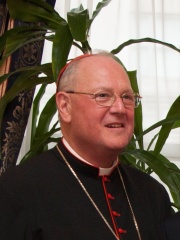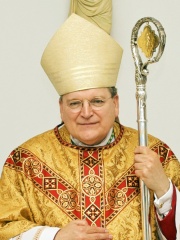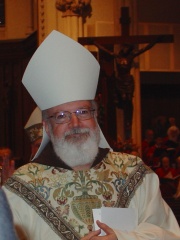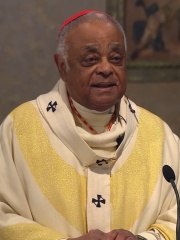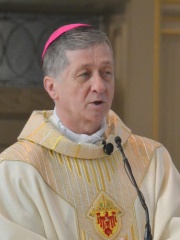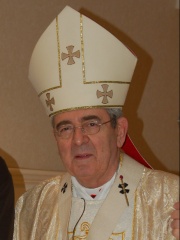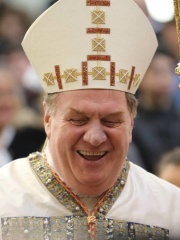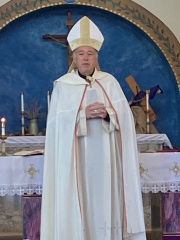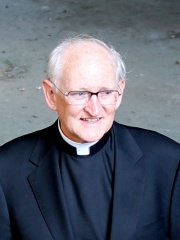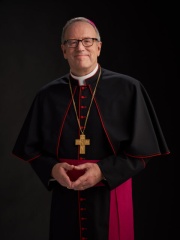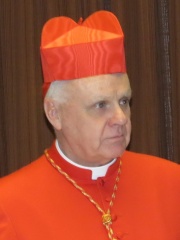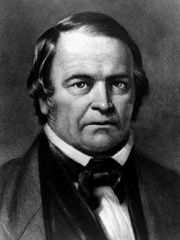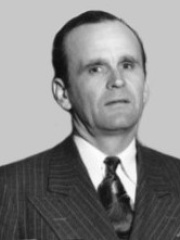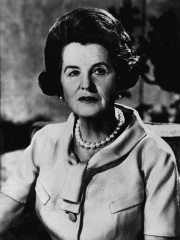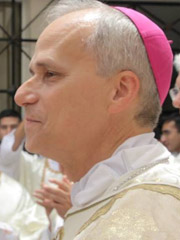
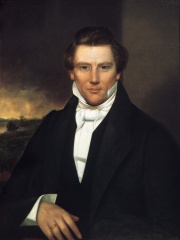
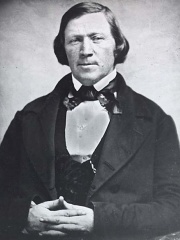
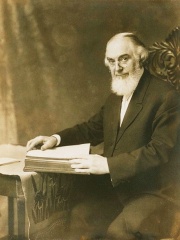
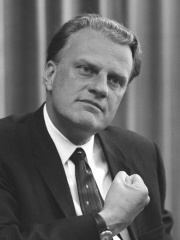

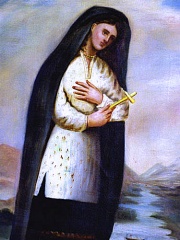
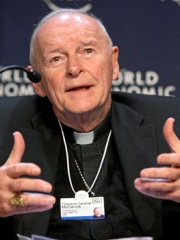
The Most Famous
RELIGIOUS FIGURES from United States
This page contains a list of the greatest American Religious Figures. The pantheon dataset contains 3,187 Religious Figures, 124 of which were born in United States. This makes United States the birth place of the 5th most number of Religious Figures behind Türkiye, and Germany.
Top 10
The following people are considered by Pantheon to be the top 10 most legendary American Religious Figures of all time. This list of famous American Religious Figures is sorted by HPI (Historical Popularity Index), a metric that aggregates information on a biography's online popularity. Visit the rankings page to view the entire list of American Religious Figures.

1. Pope Leo XIV (b. 1955)
With an HPI of 89.52, Pope Leo XIV is the most famous American Religious Figure. His biography has been translated into 143 different languages on wikipedia.
Pope Leo XIV (born Robert Francis Prevost, September 14, 1955) is the head of the Catholic Church and sovereign of Vatican City. He is the first pope to have been born in the United States, the first to hold either U.S. or Peruvian citizenships, the first from the Order of Saint Augustine, and the second (after his immediate predecessor Pope Francis) from the Americas. Prevost was born in Chicago and raised in the nearby suburb of Dolton, Illinois. He became a friar in the Order of Saint Augustine in 1977 and was ordained as a priest in 1982. He earned a Doctor of Canon Law (JCD) degree in 1987 from the Pontifical University of Saint Thomas Aquinas in Rome. His service includes extensive missionary work in Peru in the 1980s and 1990s, during which he worked as a parish pastor, diocesan official, seminary teacher, and administrator. Elected prior general of the Order of Saint Augustine, he was based in Rome from 2001 to 2013, and traveled extensively as part of this work, including to the order's many provinces and missions around the world. He then returned to Peru as Bishop of Chiclayo from 2015 to 2023. In 2023, Pope Francis appointed him prefect of the Dicastery for Bishops in Rome, and president of the Pontifical Commission for Latin America. Upon his return to Rome in 2023, Prevost was made a cardinal by Pope Francis. As Cardinal, Prevost emphasized synodality, missionary dialogue, and engagement with social and technological challenges. He has also addressed issues such as climate change, global migration, church governance, and human rights, and expressed alignment with the reforms of the Second Vatican Council and the direction set for the Church by Francis. Prevost's election in the 2025 conclave was unexpected by observers; he was a dark horse candidate, with Vatican insiders believing the prospect of a pope from the United States to be unrealistic given its status as a superpower. In honor of Pope Leo XIII, who developed modern Catholic social teaching amid the tumult of the Second Industrial Revolution, Prevost chose the papal name Leo XIV—both to echo Leo XIII's concern for workers and fairness, and as a response to the challenges of a new industrial revolution and artificial intelligence.

2. Joseph Smith (1805 - 1844)
With an HPI of 85.34, Joseph Smith is the 2nd most famous American Religious Figure. His biography has been translated into 94 different languages.
Joseph Smith Jr. (December 23, 1805 – June 27, 1844) was an American religious and political leader and the founder of Mormonism and the Latter Day Saint movement. Publishing the Book of Mormon at the age of 24, Smith attracted tens of thousands of followers by the time of his death fourteen years later. The religious movement he founded is followed by millions of global adherents and several churches, the largest of which is the Church of Jesus Christ of Latter-day Saints (LDS Church). Born in Sharon, Vermont, Smith moved with his family to Western New York amid hardships following a series of crop failures in 1816. Living in an area of intense religious revivalism during the Second Great Awakening, Smith reported experiencing a series of visions. The first of these was in 1820, when he saw "two personages" (whom he eventually described as God the Father and Jesus Christ). In 1823, he said he was visited by an angel who directed him to a buried book of golden plates inscribed with a Judeo-Christian history of an ancient American civilization. In 1830, Smith published the Book of Mormon, which he described as an English translation of those plates. The same year he organized the Church of Christ, calling it a restoration of the early Christian Church. Members of the church were later called Latter Day Saints or nicknamed the Mormons. In 1831, Smith and his followers moved west, planning to build a communal Zion in the American heartland. They first gathered in Kirtland, Ohio, and established an outpost in Independence, Missouri, which was intended to be Zion's central location. During the 1830s, Smith sent out missionaries, published revelations, and supervised construction of the Kirtland Temple. Smith and his followers left Ohio and Missouri after the collapse of the church-sponsored Kirtland Safety Society and violent skirmishes with non-Mormon Missourians escalated into the Mormon extermination order. They established a new settlement at Nauvoo, Illinois, which quickly grew to be the second-largest city in Illinois during Smith's mayoralty. Smith launched a presidential campaign in 1844. During his campaign, Smith and the Nauvoo City Council ordered the destruction of the Nauvoo Expositor's printing press after it criticized Smith's power and his practice of polygamy. This inflamed opposition to Smith and his followers. Smith surrendered to Illinois authorities but was shot and killed by a mob that stormed the jailhouse. During his ministry, Smith published numerous documents and texts, many of which he attributed to divine inspiration and revelation from God. He dictated the majority of these in the first-person, saying they were the writings of ancient prophets or expressed the voice of God. His followers accepted his teachings as prophetic and revelatory, and several of these texts were canonized by denominations of the Latter Day Saint movement, which continue to treat them as scripture. Smith's teachings discuss God's nature, cosmology, family structures, political organization, and religious community and authority. Mormons generally regard Smith as a prophet comparable to Moses and Elijah. Several religious denominations identify as the continuation of the church that he organized, including the LDS Church and the Community of Christ.

3. Brigham Young (1801 - 1877)
With an HPI of 81.74, Brigham Young is the 3rd most famous American Religious Figure. His biography has been translated into 52 different languages.
Brigham Young ( BRIG-əm; June 1, 1801 – August 29, 1877) was an American religious leader and politician. He was the second president of the Church of Jesus Christ of Latter-day Saints (LDS Church) from 1847 until his death in 1877. He also served as the first governor of the Utah Territory from 1851 until his resignation in 1858. Young was born in 1801 in Vermont and raised in Upstate New York. After working as a painter and carpenter, he became a full-time LDS Church leader in 1835. Following a short period of service as a missionary, he moved to Missouri in 1838. Later that year, Missouri governor Lilburn Boggs signed the Mormon Extermination Order, and Young organized the migration of the Latter Day Saints from Missouri to Illinois, where he became an inaugural member of the Council of Fifty. In 1844, while he was traveling to gain support for Joseph Smith's presidential campaign, Smith was killed by a mob, igniting the Illinois Mormon War and triggering a succession crisis in the Latter Day Saint movement. After negotiating a ceasefire, Young was unanimously elected as the church's second president in 1847. During the Mormon exodus, Young led his followers west from Nauvoo, Illinois, via the Mormon Trail to the Salt Lake Valley. Once settled in Utah, he ordered the construction of numerous temples, including the Salt Lake Temple. He also formalized the prohibition of black men attaining priesthood and directed the Mormon Reformation. A supporter of education, Young worked to establish the learning institutions that would later become the University of Utah and Brigham Young University. After arriving in Utah, Young founded Salt Lake City and established the State of Deseret before being appointed Utah's first territorial governor by President Millard Fillmore in 1850. As governor, Young allowed polygamy, supported slavery and its expansion into Utah, and led the efforts to legalize and regulate slavery in the 1852 Act in Relation to Service, based on his beliefs on slavery. He exerted considerable power over the territory through his theocratic political system, theodemocracy. After President James Buchanan appointed a new governor of the territory, Young declared martial law and re-activated the Nauvoo Legion, beginning the Utah War. During the conflict, the Utah Territorial Militia committed a series of attacks that resulted in the mass murder of at least 120 members of the Baker–Fancher immigrant wagon train, known as the Mountain Meadows Massacre. The following month, the Aiken massacre was perpetrated on Young's orders. In 1858, the war ended when Young surrendered; agreeing to resign as governor and allow federal troops to enter the Utah Territory in exchange for a pardon granted to Mormon settlers from President Buchanan. A polygamist, Young had 56 wives and 57 children. His teachings are contained in the 19 volumes of transcribed and edited sermons in the Journal of Discourses. His legacy and impact are seen throughout the American West, including numerous memorials, temples, and schools named in his honor. In 2016, Young was estimated to have around 30,000 descendants.

4. Charles Taze Russell (1852 - 1916)
With an HPI of 76.57, Charles Taze Russell is the 4th most famous American Religious Figure. His biography has been translated into 42 different languages.
Charles Taze Russell (February 16, 1852 – October 31, 1916), or Pastor Russell, was an American Adventist minister from Pittsburgh, Pennsylvania, and founder of the Bible Student movement. He was an early Christian Zionist. In July 1879, Russell began publishing a monthly religious magazine, Zion's Watch Tower and Herald of Christ's Presence. In 1881, he co-founded Zion's Watch Tower Tract Society with William Henry Conley as president. In 1884 the corporation was registered, with Russell as president. Russell wrote many articles, books, tracts, pamphlets and sermons, totaling approximately 50,000 pages. From 1886 to 1904, he published a six-volume Bible study series titled Millennial Dawn, later renamed Studies in the Scriptures, nearly 20 million copies of which were printed and distributed around the world in several languages during his lifetime. (A seventh volume was commissioned by his successor as society president, Joseph Rutherford, and published in 1917.) The Watch Tower Society ceased publication of Russell's writings in 1927, though his books are still published by several independent groups. After Russell's death, a crisis surrounding Rutherford's leadership of the society culminated in a movement-wide schism. As many as three-quarters of the approximately 50,000 Bible Students associated in 1917 had left by 1931. This resulted in the formation of several groups with variations of the name Bible Students. Those who remained associated with the Watch Tower Society adopted the name Jehovah's witnesses in 1931, while those who severed ties with the Society formed their own groups including the Pastoral Bible Institute in 1918, the Laymen's Home Missionary Movement in 1919, and the Dawn Bible Students Association in 1929.
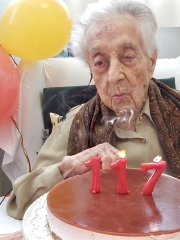
5. Maria Branyas (1907 - 2024)
With an HPI of 75.38, Maria Branyas is the 5th most famous American Religious Figure. Her biography has been translated into 34 different languages.
Maria Branyas Morera (Catalan: [məˈɾiə ˈβɾaɲəs]; 4 March 1907 – 19 August 2024) was an American-Catalan supercentenarian who, until her death at the age of 117 years, 168 days, was the world's oldest verified living person, following the death of Lucile Randon on 17 January 2023.

6. Billy Graham (1918 - 2018)
With an HPI of 71.62, Billy Graham is the 6th most famous American Religious Figure. His biography has been translated into 69 different languages.
William Franklin Graham Jr. (; November 7, 1918 – February 21, 2018) was an American evangelist, ordained Southern Baptist minister, and civil rights advocate, whose broadcasts and world tours featuring live sermons became well known in the mid-to-late 20th century. Throughout his career, spanning over six decades, Graham rose to prominence as an evangelical Christian figure in the United States and abroad. According to a biographer, Graham was considered "among the most influential Christian leaders" of the 20th century. Beginning in the late 1940s and early 1950s, Graham became known for filling stadiums and other massive venues around the world where he preached live sermons; these were often broadcast via radio and television with some continuing to be seen into the 21st century. During his six decades on television, Graham hosted his annual "crusades", evangelistic live-campaigns, from 1947 until his retirement in 2005. He also hosted the radio show Hour of Decision from 1950 to 1954. He repudiated racial segregation, at a time of intense racial strife in the United States, insisting on racial integration for all of his revivals and crusades, as early as 1953. He also later invited Martin Luther King Jr. to preach jointly at a revival in New York City in 1957. In addition to his religious aims, he helped shape the worldview of a huge number of people who came from different backgrounds, leading them to find a relationship between the Bible and contemporary secular viewpoints. According to his website, Graham spoke to live audiences consisting of at least 210 million people, in more than 185 countries and territories, through various meetings, including BMS World Mission and Global Mission events. Graham was close to US presidents Dwight D. Eisenhower, Lyndon B. Johnson (one of his closest friends), and Richard Nixon. He was also lifelong friends with Robert Schuller, another televangelist and the founding pastor of the Crystal Cathedral, whom Graham talked into starting his own television ministry. Graham's evangelism was appreciated by mainline Protestant denominations, as he encouraged mainline Protestants, who were converted to his evangelical message, to remain within or return to their mainline churches. Despite early suspicions and apprehension on his part towards Catholicism—common among contemporaneous evangelical Protestants—Graham eventually developed amicable ties with many American Catholic Church figures, later encouraging unity between Catholics and Protestants. Graham operated a variety of media and publishing outlets; according to his staff, more than 3.2 million people have responded to the invitation at Billy Graham Crusades to "accept Jesus Christ as their personal savior". Graham's lifetime audience, including radio and television broadcasts, likely surpassed billions of people. As a result of his crusades, Graham preached the gospel to more people, live and in-person, than anyone in the history of Christianity. Graham was on Gallup's list of most admired men and women a record 61 times. Grant Wacker wrote that, by the mid-1960s, he had become the "Great Legitimator", saying: "By then his presence conferred status on presidents, acceptability on wars, shame on racial prejudice, desirability on decency, dishonor on indecency, and prestige on civic events."

7. Henry Molaison (1926 - 2008)
With an HPI of 71.53, Henry Molaison is the 7th most famous American Religious Figure. His biography has been translated into 26 different languages.
Henry Gustav Molaison (February 26, 1926 – December 2, 2008), known widely as H.M., was an American epileptic man who in 1953 received a bilateral medial temporal lobectomy to surgically resect parts of his brain—the anterior two thirds of his hippocampi, parahippocampal cortices, entorhinal cortices, piriform cortices, and amygdalae—in an attempt to cure his epilepsy. Although the surgery was partially successful in controlling his epilepsy, a severe side effect was that he became unable to form new memories. His unique case also helped define ethical standards in neurological research, emphasizing the need for patient consent and the consideration of long-term impacts of medical interventions. Furthermore, Molaison's life after his surgery highlighted the challenges and adaptations required for living with significant memory impairments, serving as an important case study for healthcare professionals and caregivers dealing with similar conditions. A childhood bicycle accident is often advanced as the likely cause of H.M.'s epilepsy. H.M. began to have minor seizures at age 10; from 16 years of age, the seizures became major. Despite high doses of anticonvulsant medication, H.M.'s seizures were incapacitating. When he was 27, H.M. was offered an experimental procedure by neurosurgeon William Beecher Scoville. Previously, Scoville had only ever performed the surgery on psychotic patients. H.M. was extensively studied from late 1957 until his death in 2008. He resided in a care institute in Windsor Locks, Connecticut, where he was the subject of ongoing investigations. His case played an important role in the development of theories that explain the link between brain function and memory, and in the development of cognitive neuropsychology, a branch of psychology that aims to understand how the structure and function of the brain relates to specific psychological processes. Molaison's brain was kept at University of California, San Diego, where it was sliced into histological sections on December 4, 2009. It was later moved to the MIND Institute at UC Davis. The brain atlas constructed from him was made publicly available in 2014.

8. Kateri Tekakwitha (1656 - 1680)
With an HPI of 71.48, Kateri Tekakwitha is the 8th most famous American Religious Figure. Her biography has been translated into 35 different languages.
Kateri Tekakwitha (pronounced [ˈɡaderi deɡaˈɡwita] in Mohawk), given the name Tekakwitha (Tekaouïta, baptized as Catherine ("Kateri" in Mohawk), known as Lily of the Mohawks (1656 – April 17, 1680) and Protectress of Canada, also as Geneviève of New France/ Geneviève of Canada, was a Mohawk/Algonquin young woman when she converted to Catholicism. Committing to live as a virgin, she became known for her devotion to Jesus Christ, diligent work ethic, and dedicated prayers for her fellow Native people. She was canonized in 2012, the first Native American saint. Born in the Mohawk village of Ossernenon, in present-day New York, she and her family contracted smallpox in an epidemic; she was the only one of the family to survive, but had scarring on her face. She was influenced by French Jesuit missionaries and converted to Catholicism at age 19. After taking a vow of perpetual virginity, she left her village, and moved to the Jesuit mission village of Kahnawake, just south of Montreal. There she died five years later, respected for her piety and good works. She was beatified in 1980 by Pope John Paul II, and canonized by Pope Benedict XVI at Saint Peter's Basilica on 21 October 2012, along with six others: Jacques Berthieu, Pedro Calungsod, Giovanni Battista Piamarta, Maria of Mt Carmel Salles y Barangueras, Marianne of Molokaʻi, and Anna Schäffer.

9. Theodore Edgar McCarrick (1930 - 2025)
With an HPI of 70.39, Theodore Edgar McCarrick is the 9th most famous American Religious Figure. His biography has been translated into 24 different languages.
Theodore Edgar McCarrick (July 7, 1930 – April 3, 2025) was an American Roman Catholic bishop and cardinal who was Archbishop of Newark from 1986 to 2000 and Archbishop of Washington from 2001 to 2006. In 2019, McCarrick was dismissed and laicized by Pope Francis after being convicted of sexual misconduct in a canonical trial. Ordained a priest in 1958, McCarrick became an auxiliary bishop of the Archdiocese of New York in 1977. He then became Bishop of Metuchen in 1981. From 1986 to 2000, he served as Archbishop of Newark. He was appointed Archbishop of Washington in 2000 and made a cardinal in 2001. A prolific fundraiser, he was connected to prominent politicians and was considered a power broker in Washington, D.C. After his mandatory age-related retirement from Washington in 2006, he continued traveling the globe on the unofficial behalf of Pope Francis. Within the church, McCarrick was generally regarded as a champion of progressive Catholics. McCarrick was accused of engaging in sexual misconduct with adult male seminarians. Multiple reports about his alleged misconduct were made to American bishops and the Holy See, but McCarrick vehemently denied the allegations to the Vatican. After a credible allegation of repeated sexual misconduct towards boys and seminarians was lodged with the Archdiocese of New York, McCarrick was removed from public ministry in 2018. The following month, The New York Times published a story detailing a pattern of sexual abuse of male seminarians and minors by McCarrick, leading him to resign from the College of Cardinals. After a church investigation and trial, McCarrick was found guilty of sexual crimes against adults and minors and abuse of power and dismissed from the clerical state in 2019. He was the most senior church official in modern times to be laicized, and his was the first known case of a cardinal resigning from the College of Cardinals and being laicized for sexual abuse. McCarrick's case sparked demands for accountability and reform in the Catholic Church. Pope Francis ordered "a thorough study" of the Vatican's records on McCarrick "to ascertain all the relevant facts, to place them in their historical context and to evaluate them objectively". The study was published by the Secretariat of State in 2020.
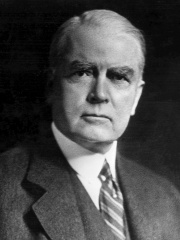
10. John Mott (1865 - 1955)
With an HPI of 70.17, John Mott is the 10th most famous American Religious Figure. His biography has been translated into 51 different languages.
John Raleigh Mott (May 25, 1865 – January 31, 1955) was an American evangelist and long-serving leader of the Young Men's Christian Association (YMCA) and the World Student Christian Federation (WSCF). He received the Nobel Peace Prize in 1946 for his work in establishing and strengthening international Protestant Christian student organizations that worked to promote peace. He shared the prize with Emily Greene Balch. From 1895 until 1920 Mott was the General Secretary of the WSCF. Intimately involved in the formation of the World Council of Churches in 1948, that body elected him as a lifelong honorary President. He helped found the World Student Christian Federation in 1895, the 1910 World Missionary Conference and the World Council of Churches in 1948. His best-known book, The Evangelization of the World in this Generation, became a missionary slogan in the early 20th century.
People
Pantheon has 124 people classified as American religious figures born between 1585 and 1991. Of these 124, 32 (25.81%) of them are still alive today. The most famous living American religious figures include Pope Leo XIV, Timothy M. Dolan, and Raymond Leo Burke. The most famous deceased American religious figures include Joseph Smith, Brigham Young, and Charles Taze Russell. As of April 2024, 1 new American religious figures have been added to Pantheon including John Allen Chau.
Living American Religious Figures
Go to all RankingsPope Leo XIV
1955 - Present
HPI: 89.52
Timothy M. Dolan
1950 - Present
HPI: 68.12
Raymond Leo Burke
1948 - Present
HPI: 67.47
Seán Patrick O'Malley
1944 - Present
HPI: 66.36
Wilton Daniel Gregory
1947 - Present
HPI: 65.80
Blase J. Cupich
1949 - Present
HPI: 65.23
Justin Francis Rigali
1935 - Present
HPI: 64.21
Joseph W. Tobin
1952 - Present
HPI: 62.71
Robert W. McElroy
1954 - Present
HPI: 62.58
James Michael Harvey
1949 - Present
HPI: 61.11
Robert Barron
1959 - Present
HPI: 59.17
Edwin Frederick O'Brien
1939 - Present
HPI: 59.15
Deceased American Religious Figures
Go to all RankingsJoseph Smith
1805 - 1844
HPI: 85.34
Brigham Young
1801 - 1877
HPI: 81.74
Charles Taze Russell
1852 - 1916
HPI: 76.57
Maria Branyas
1907 - 2024
HPI: 75.38
Billy Graham
1918 - 2018
HPI: 71.62
Henry Molaison
1926 - 2008
HPI: 71.53
Kateri Tekakwitha
1656 - 1680
HPI: 71.48
Theodore Edgar McCarrick
1930 - 2025
HPI: 70.39
John Mott
1865 - 1955
HPI: 70.17
William Miller
1782 - 1849
HPI: 67.28
William M. Branham
1909 - 1965
HPI: 66.12
Rose Kennedy
1890 - 1995
HPI: 65.68
Newly Added American Religious Figures (2025)
Go to all RankingsOverlapping Lives
Which Religious Figures were alive at the same time? This visualization shows the lifespans of the 25 most globally memorable Religious Figures since 1700.

